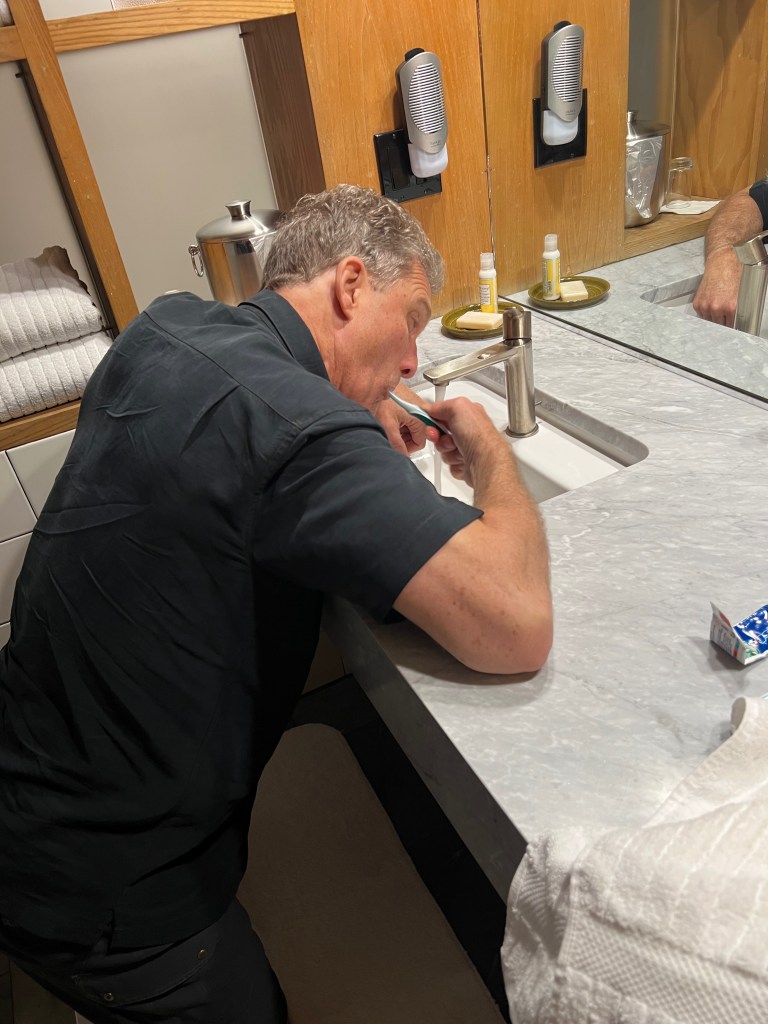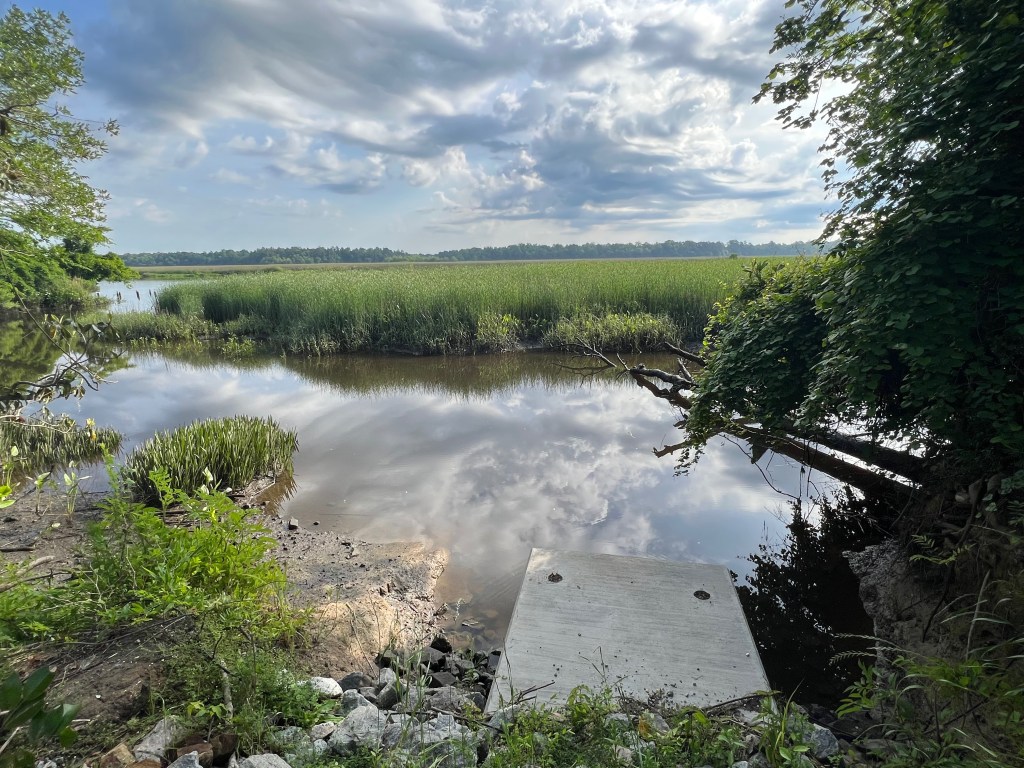Middleton Place is in a beautiful location, twenty minutes outside Charleston, and feels like a step back in time. We chose to stay there because lodging in downtown Charleston is so expensive.
Review of The Inn at Middleton Place

The inn is actually a series of Frank Lloyd Wright styled buildings that are located next to the grounds of Middleton Place. The buildings are modern and attractive, and the interiors visually appealing. However, I think they could make some improvements. For one thing, the bathroom counters are so low, I think they were built for midgets!

Our bed was alright, but starting to sink in uncomfortable places. And though there were lots of windows, none of them opened (there was a fan/AC). We would have liked to open a window to hear the nightly crickets and pattering rain.
Housecleaning was not thorough – we had to ask for it, and they never swept our floor or cleaned the sinks. The breakfast buffet was as good as could be expected.
I’m only complaining because the inn has so much potential, and if they improved in the areas I mentioned, it would really be outstanding.
The Grounds of Middleton Place
Middleton Place is a national historic landmark consisting of 110 acres that include one of the oldest landscaped gardens in America, a house museum, stable yards, former slave home, and restaurant. If you stay at the inn, tours of the garden and stable yards are included, as well as an excellent lecture about the enslaved experience at Middleton Place. It is called Beyond The Fields. (I will cover more on slavery in another blog.)
A tour of the house museum costs $15/person.

We spent a day exploring the grounds and taking the tours. I definitely recommend any visitors to Charleston spend a day at Middleton Place. Their restaurant is good too. Be sure you get the pecan pie with malted whip creme, topped with cinnamon ice-cream. It is To Die For.

The Mill Museum
One of our favorite tours was a self-guided museum tour of the old mill.

In 1741, Henry Middleton received Middleton Place (200 acres at that time) as a dowry gift. Because Henry already owned 19 plantations of about 1000 acres each, he used Middleton Place as his headquarters. He did not use it as an active plantation.
The Mill at Middleton Place was built in the 1850’s, damaged by Union soldiers in 1865, and repaired and used as a storage building after that. Today the small building houses a museum. It showcases the work that used to be required, by the enslaved, to plant and harvest rice on Middleton plantations.


The Middleton’s did not grow cotton, they grew rice. They enslaved thousands to work their plantations. Rice fields once dominated the landscape on both sides of the Ashley River.

The Garden Tour
Our garden tour was led by Greg – an older marine-veteran with a wonderful Southern drawl. We didn’t cover much ground, but he shared interesting facts and gave us a surprise (more on that later).
Henry Middleton wanted his gardens to emulate the ones at Versailles. It took fifteen years to complete his vision. They are formal gardens and have four main characteristics: geometry; symmetry and balance; use of nature (land or water); and surprises, such as a little path off to the side.

Greg also told us about Spanish moss. It hangs all over oak trees throughout the south. Spanish moss is neither Spanish nor a moss. It is actually an epiphyte – a type of air plant. It gets all its nutrients and moisture from the air. Spanish moss can only hurt a tree in one way – if the tree gets overgrown with moss, and the moss gets soaked with rain water, the weight of it can snap a limb.

Horses and sheep like to eat Spanish moss, and birds use it for nesting material. At one point, even Henry Ford – the maker of the Ford automobile – tried to use it.
After traveling through the South one time, Ford thought, ‘why waste money stuffing my car and truck seats with cotton? I’ll use Spanish Moss.’ He tried it, and sold cars to customers, who initially thought the seats were very comfortable. However, a few days later, customers began returning the cars. They complained that something in the seat cushions was biting them! Turns out, the larvae of little red bugs, called chiggers, live in the moss and sometimes bite people! Ford had to re-stuff all the auto and truck cushions with cotton. “And that,” Greg pointed out, “was the first automotive recall.”
The Surprise
Here’s the story as related by my husband (he remembered the details better).
The guide suddenly paused with a slight pained expression, tapping his jaw. Karen asked if he was okay. Greg answered, “When I was in Vietnam, a large explosion went off behind my back. They took an x-ray of my chest and neck area. The x-ray went a little high ( he gestured to his jaw). The doc said, “You have dog-jaw.” That’s got nothing to do with a dog’s jaw, but it causes a rare nerve condition. You see it looks like this . . .” Greg proceeds to take his walking stick and trace a curve in the sand with a small protruding portion. This here is dog-jaw c(
“Now you see if you touch it,” Greg asks a lady standing near to place her finger on his cheek bone, pointing to the exact spot. As she touches the side of his cheek, he quickly turns his head 90 degrees toward her and belts out, “RUFF, RUFF, RUFF!!” shocking the unsuspecting lady. The rest of the group burst into laughter. Then Greg said, “and the moral of the story is, never trust a Southern boy!”
Greg added that he used to tell that story to school children. It startled them, but then he’d see them all over the school yard teaching the other kids about “dog-jaw.”

One more funny story
This story is on me. I was outside our room on the lawn, looking through my binoculars at the Chimney Swifts darting through the air, when I heard a boat come along the Ashley River below me. I could hear teenagers talking and bottles clinking; so out of curiosity, I looked through my binoculars to see what was going on. I was just in time to see three boys taking a piss on the river–one on the stern, and one on each side of the boat. Girls were standing in the middle of the boat, trying not to look, while the boys were laughing and doing their business. I laughed too, but quickly put down my binoculars!
Short Video of Middleton Place
Here’s a two-minute video I put together of Middleton Place. Be sure to unmute it!
Stay tuned for more stories about Charleston and Savannah in my upcoming blogs. And here’s a link to the first one if you missed it. Thanks for reading!




Thank you for that very interesting story about Henry Ford and the first recall in automotive history. So many beautiful pictures too.
Just one question: why wasn’t Bill brushing his teeth with his phone?
Ha ha! Glad you enjoyed it Jeannine.